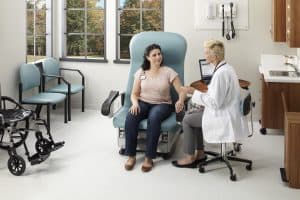Gone are the days when patients had no other option than to climb up onto an uncomfortable, fixed height table for an exam – a setting that often hindered accessibility options and contributed to white coat syndrome. Instead, changes in the healthcare industry (e.g., shifting demographics, technology advances, value-based reimbursement) are helping evolve and redefine the examination table as a clinical hub where diagnostics, patient engagement and treatment intersect to improve the quality of care.
In many ambulatory settings, there is no longer even an exam table, but rather a comfortable exam chair that blends the requirements of a clinical device and the design elements of a piece of furniture. Exam chairs are designed to be patient-centered, enhancing patient comfort while allowing caregivers to remain in the proper working position throughout exams and procedures.
Following are three important ways the exam chair continues to evolve.
Supporting Value-Based Care and Better Outcomes
As value-based models of payment emerge, some exam chairs can help clinicians work toward achieving Merit-Based Incentive Payment System (MIPS) quality metrics used in calculating provider payment.
Three MIPS metrics focus on blood pressure (BP) measurement (Controlling BP, Hypertension: Improvement in BP, and Preventive Screening for High BP). The positioning of a patient plays a significant role in BP measurement. For instance, variations in positioning and technique can lead to fluctuations of 5 to 15 mmHg in systolic blood pressure. Reviews suggest that even a difference of 5 mmHg can affect close to 16 percent of patients, either inadvertently placing them on medication or missing a diagnosis of hypertension.
Adjustable exam chairs help standardize and simplify the BP measurement process so caregivers can take readings in a consistent manner and follow American Heart Association (AHA) guidelines. Low seat height improves accessibility and promotes proper patient positioning. For instance, exam chairs that can lower to a height of 15.5 inches allow the majority of patients, including females with heights in the third percentile, to place their feet flat on the floor. Adjustable patient support rails also allow arms to be at heart height, and a patient-centered design provides back support for patient comfort and positioning.
Advancing Ergonomics/Accessibility
With the average age of patients on the rise, a growing number of patients need assistance in accessing exam chairs. The U.S. Access Board, the federal agency providing leadership and guidance for accessible design, recommends an exam chair with a low, uncompressed seat height of 17 to 19 inches. Low seat height, removable support rails and flat, wide transfer surface enable patients of varying ability levels to transfer onto and off of the exam chair with minimal assistance.
Many exam chairs are also designed with caregivers in mind in an effort to enhance their experience and increase efficiency and safety. Height adjustable chairs allow shorter and taller caregivers to work at the most appropriate height and decrease the amount of overreaching, twisting or bending during the exam.
Improving Connectivity
As the Internet of Things (IoT) continues to transform the way we interact with equipment, data and each other, it is bringing a new level of connectivity to ambulatory care, including the exam chair. The result is improved data accuracy and enhanced workflows.
Some exam chairs feature a built-in scale that captures weight data while the patient sits comfortably, eliminating weighing stations that are often out in the open. That data can then be transmitted directly to the electronic health records (EHR) system. This decreases the possibility of errors in both reading the scale and transcribing it into the patient’s record.
As the level of connectivity continues to increase, even more diagnostic and vital signs information will be gathered and shared by the chair. For instance, vital signs monitors are starting to be connected with the exam chair to help reduce errors in vital signs acquisition. These diagnostic devices change the traditional workflow in vitals signs acquisition by establishing a direct wireless connection between the vital signs device, the exam chair and the caregiver’s tablet or laptop. Caregivers can take vital signs, review results and seamlessly port the information to EHR systems within one computer screen–from a “single pane of glass.”
The exam chair that most patients encounter today is more advanced, comfortable and versatile than the fixed-height table from many years ago. It is quickly becoming a foundational component of the connected point of care ecosystem, providing support for achieving value-based reimbursement efforts and improving clinical outcomes.
Kurt Forsthoefel is director of medical marketing for Midmark.
The Editorial Team at Healthcare Business Today is made up of skilled healthcare writers and experts, led by our managing editor, Daniel Casciato, who has over 25 years of experience in healthcare writing. Since 1998, we have produced compelling and informative content for numerous publications, establishing ourselves as a trusted resource for health and wellness information. We offer readers access to fresh health, medicine, science, and technology developments and the latest in patient news, emphasizing how these developments affect our lives.








